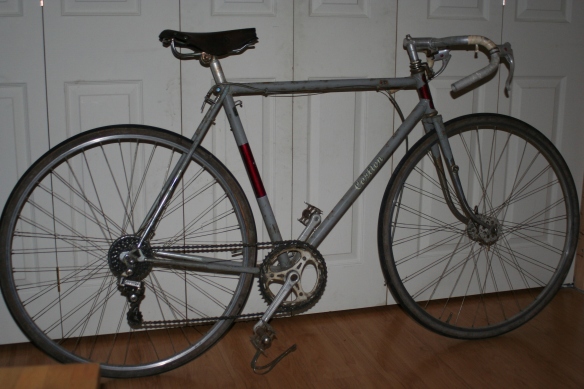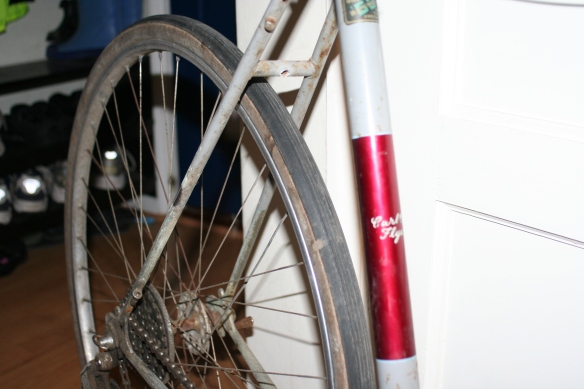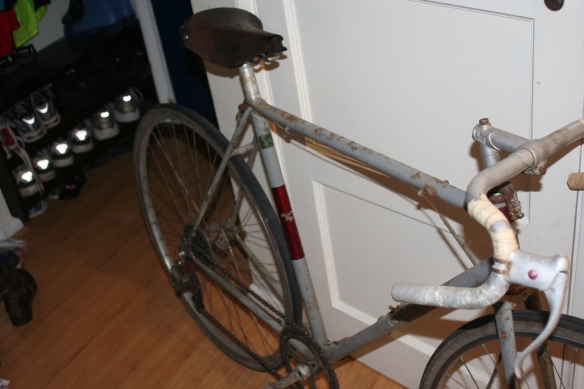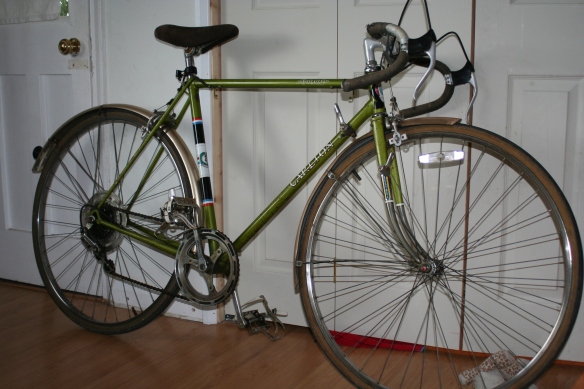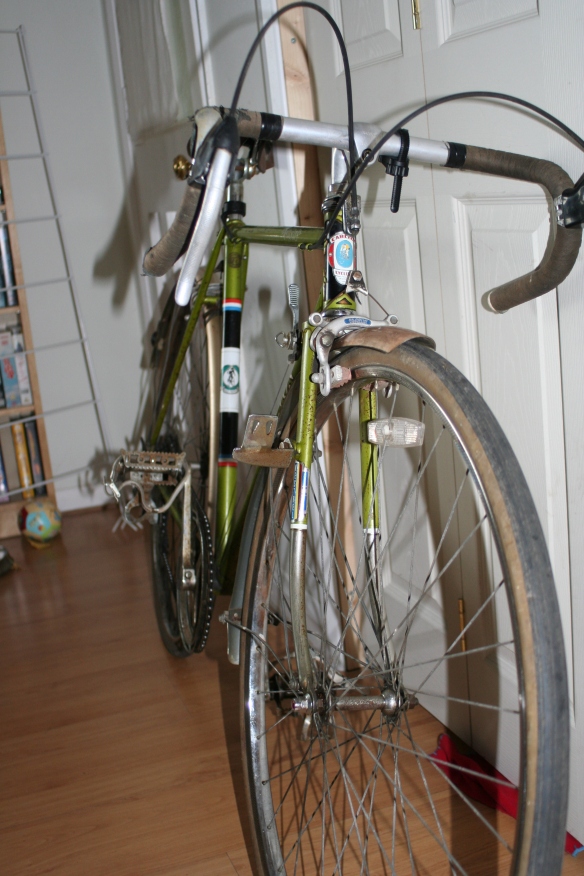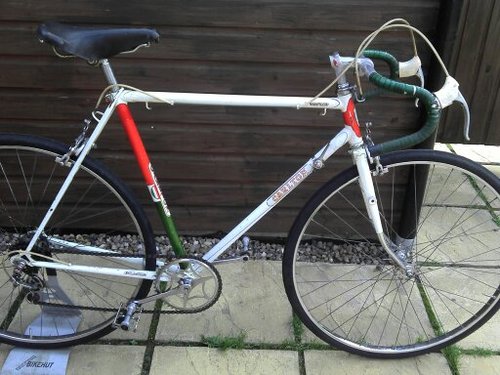At last I found some time to get the Falcon singlespeed on the road. I still have a few details to sort out, not least of which is repainting the frame, but I decided to build it up initially as it stands, with the rough light blue Hammerite paintjob I bought it with. Perhaps strangely, I think it has character. And with all the shiny new and reclaimed components it looks good too.

Falcon Olympic Fixie
I had a few jobs remaining to do to get it on the road. In roughly this order: build back wheel, fit headset, fit bottom bracket, cranks and pedals, sort chainline and fit brakes, stem, bars, wheels, tyres, saddle and seatpost.
I built the back wheel last weekend (Superbe Pro hub, Mavic Open Pro rim, Sapim Race double butted spokes). I’m getting the hang of wheel building and it was much easier doing this than the front wheel. To the completed wheel I fitted a 17 tooth Gusset steel fixed cog from Charlie the Bikemonger, who also supplied the KMC Z610HX chain. It’s well shiny and really sets off the polished metal on the bike.
I then set about getting the chainline right. I assembled the Campy bottom bracket (112 mm) into the frame, then fitted my Suntour Superbe Pro cranks with the Velosolo 48 tooth chainring. With the wheel in place I could see first of all that I had the rim nicely centred for the frame, but also the chainwheel was sitting out from the cog by about 5mm.
As there was plenty of clearance on the frame I figured a narrower bottom bracket would be fine. To get 5mm closer I needed a 10mm narrower bottom bracket. It needed to be English threaded with ISO taper. And not too pricey. Plus it needed a good deep threaded section on the cups as my bottom bracket shell is pretty worn on the drive side with most of the outer thread badly worn.

Drivetrain
So, I shopped about and settled on a Token. I was trying to find a steel shelled BB like the campy, so that the few threads in use on the drive side would be nice and strong, but no luck. Token offer a wide range of sizes and configs, and they all fit using a Shimano spline pattern which is useful, although you can get a better grip for fitting on the Campy design.
I was going to get the BB from Velosolo, the service there is great and they are clearly very knowledgeable, but Wiggle had the same BB for about £5 cheaper (£17.99 with free postage) so I sold out to the big guys on this one. However it took over a week to arrive, so that served me right.
When the Token BB arrived I took a good look. It has nice smooth running bearings and it’s double sealed with a carbon shell. For a budget BB it’s light and apparently well made with an expensive looking finish to it. Usefully for the Falcon frame the threaded section on the cups is very deep, around 17mm each side (compared to 12mm for the Campagnolo bottom bracket or even 8mm for an FSA). On the drive side of my frame, about the first 7mm of thread is damaged but this deeper cup is biting into another 5-6mm of good undamaged thread which seems enough to hold it very firmly. On the flip side however, the depth of the threaded section may make the cups difficult to fit in some frames – in fact on my non drive side I re-used an old steel FSA shell because the aluminium thread was binding for the last 5mm in the previously unused inner section of thread on the frame.
Once the narrower BB was fitted the chainline came up very good, with only about 0.5mm offset which I am sure it can tolerate easily. Aesthetically it works better too, holding the cranks nice and snug into the frame. In fact it just lightly touched the chainring bolts against the frame but a technical tap with the big ball peen hammer onto the chainstay sorted that in no time.

Headset... and the rest
So, next challenge the headset. I bought a Genetic Cranium alloy headset (1″ threaded) from SJS a while ago for a tenner. Brilliant value and nicely finished too. I loosely fitted it hand tight at the time and it seemed OK. I left it set up like that just to keep the frame and forks together for mounting bits up on.
On the weekend I went to fit it properly, grease the bearings and tighten it but I couldn’t get it right. It was either too tight and binding or too loose and wobbling. I noticed to my escalating concern that the lower cup that presses into the head tube was loose. Surprisingly loose in fact and could distinctly be moved about. This then would explain the problems.
Now the old Falcon frame has clearly had a hard life. The bottom bracket shell is not the best. The paint on the frame has been stripped and badly repainted in Hammerite which has itself been knocked about. I really only bought it because it’s built with Reynolds 531 steel, I like the lugs and the look of it and the seller suggested it was 10 years older than it really is (hell, it looks 50 years older than it really is!). It’s had a very hard life so it sort of makes sense that it might have been brutalised in other ways too but this is a real bummer to have the head tube worn like this. I could only assume it had been ridden for a long time with a loose or worn out headset which set up a “hammer blow” effect inside the head tube, leading to its eventual distortion.
Sorely disappointed, I seriously considered scrapping it and getting a better frame. But on reflection I decided to see about getting it brazed and reamed out in the longer term, and to see if I could use a “coke can shim” in the short term, perhaps with some JB Weld.
In the meantime, my wife’s Ron Kitching bike has a badly fitted Zeus headset (also 1″ threaded) – the top nut can’t get enough thread to lock down onto the lower nut so clearly the stack height is wrong. So I read around and saw that Tange headsets, besides being notoriously good, also have a low stack height. But before trying one I thought I would try the Genetic Cranium headset which clearly wasn’t right in the Falcon. By luck it fitted the Kitching frame perfectly. One problem solved at least.
So I took the old Zeus headset from the Kitching which although old is clearly in good nick. Being steel I thought it might be a slightly better, if heavier, candidate for any bodge work required on the Falcon.
To my surprise it was a very good fit into the Falcon’s head tube, tight enough to require a good hit with the trusty heavy ball peen and a block of wood. (I had noticed the Cranium slipped easily into the Kitching but it still needed a tap to get it home). So nothing wrong with the head tube after all. Massive relief. All it needed now was a 5mm x 1″ alloy spacer (£1.99 Brand X from Chain Reaction) and the headset is now spot on.
That was the last hurdle crossed. Now I fitted the wheels, the KMC chain, the stem and the lovely old Dawes drop bars I got a while ago. Suddenly she was looking like a proper bike. All it needed was pedals and a saddle, and I had already ordered the former.
Next morning the pedals arrived, MKS GR-9 from Velosolo. Fast service as usual. I still didn’t have a saddle yet so I used the crap one that came on the Kitching and was now spare. I fitted a pair of toeclips (Italian made, old stock from Spa Cycles). Brakes could wait till later I decided.

Falcon ready to fly
I took her out for a little ride down the road. A slight battle with the toeclips (damn pedals were a moving target – I forgot to say, I’m a fixie virgin) but everything else fine. So quiet, smooth and she looks brilliant. I’m going to need a bit of practice before doing the 10 mile commute to work however.

